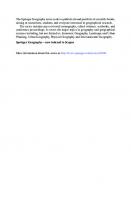In 1926: Living on the Edge of Time 9780674038042
Gumbrecht evokes the year 1926 through explorations of such things as bars, boxing, movie palaces, hunger artists, airpl
231 62 34MB
English Pages 521 Year 2009
Recommend Papers

- Author / Uploaded
- Hans Ulrich Gumbrecht
File loading please wait...
Citation preview
In 1926
In 1926 LIVING AT THE EDGE
OF TIME
Hans Ulrich Gumbrecht
HARVARD UNIVERSITY PRESS Cambridge, Massachusetts London, England 1997
Copyright © 1997 by the President and Fellows of Harvard College All rights reserved Printed in the United States of America Library of Congress Cataloging-in-Publication Data Gumbrecht, Hans Ulrich. In 1926: living at the edge of time I Hans Ulrich Gumbrecht. p. cm. Includes index. ISBN 0-674-00055-2 (alk. paper). - ISBN 0-674-00056-0 (pbk.: alk. paper) 1. Civilization, Modern-20th century. 2. Popular culture-History-20th century. 3. Nineteen twenty-six, A.D. 4. Civilization, Western-20th century. 1. Title. CB427.G86 1997 909.82'2-dc21 97-30904
For Ricky
CONTENTS
User's Manual •
IX
Arrays Airplanes· 3, Americans in Paris· 12, Assembly Lines· 22, Automobiles· 26, Bars· 34, Boxing· 42, Bullfighting· 54, Cremation· 62, Dancing· 66, Elevators· 75, Employees· 80, Endurance· 87, Engineers· 93, Gomina . 102, Gramophones· 108, Hunger Artists· 115, Jazz· 120, League of Nations· 126, Mountaineering· 132, Movie Palaces· 141, Mummies· 149, Murder· 155, Ocean Liners· 164, Polarities· 172, Railroads· 177, Reporters· 185, Revues· 191, Roof Gardens· 198, Six-Day Races· 203, Stars· 207, Strikes· 217, Telephones· 225, Timepieces· 233, Wireless Communication· 241
Codes Action vs. Impotence· 253, Authenticity vs. Artificiality· 262, Center vs. Periphery· 272, Immanence vs. Transcendence· 281, Individuality vs. Collectivity· 293, Male vs. Female· 303, Present vs. Past· 312, Silence vs. Noise· 320, Sobriety vs. Exuberance· 329, Uncertainty vs. Reality· 336
vii
viii
CONTENTS
Codes Collapsed
=Impotence (Tragedy) . 351, Authenticity =Artificiality (Life) ·358, Center = Periphery (Infinitude) . 364, Immanence = Transcendence (Death) . 372, Individuality = Collectivity (Leader) . 383, Male = Female (Gender Trouble) . 390, Present = Past (Eternity) ·400 Action
Frames After Learning from History· 411 Being-in-the-Worlds of 1926: Martin Heidegger, Hans Friedrich Blunck, Carl Van Vechten . 437
Notes • 481 Acknowledgments • 499 Index • 501
User's Manual
Where to Start
Do not try "to start from the beginning," for this book has no beginning in the sense that narratives or arguments have beginnings. Start with any of the fifty-one entries in any of the three sections entitled "Arrays," "Codes," and "Codes Collapsed" (the alphabetical order of the subheadings shows that there isn't any hierarchy among them). Simply start with an entry that particularly interests you. From each entry a web of cross-references will take you to other, related entries. Read as far as your interest carries you (and as long as your schedule allows). You'll thus establish your individual reading path. Just as there is no obligatory beginning, there also is no obligatory or definitive end to the reading process. Regardless of where you enter or exit, any reading sequence of some length should produce the effect to which the book's title alludes: you should feel "in 1926." The more immediate and sensual this illusion becomes, the more your reading will fulfill the book's chief aim. Note: you can, if you like, experience this effect without reading the last two chapters, "After Learning from History" and "Being-in-the-Worlds of 1926."
Mode(s)
In the sections "Arrays," "Codes," and "Codes Collapsed," the writing aims at being strictly descriptive. This discourse is meant to bring out dominant surface perceptions as they were offered by certain ix
x
USER'S MANUAL
material phenomena, and dominant world views as they were produced by certain concepts during the year 1926. Each entry refrains as far as possible from "expressing" the author's individual "voice," from in-depth interpretations, and from diachronic contextualizations through the evocation of phenomena and world views that occurred "before" and "after" 1926. Each entry is thus supposed to reach maximum surface-focus and concreteness. If possible at all, the style and the structure of the entries would be determined by the individual phenomena that each of them thematizes. In their convergence and divergence, finally, the entries do not seek to produce any specific "mood" (or Stimmung). Should some readers discover, for example, a certain "Heideggerian temper" in this book, such an impression would have to be explained as a symptom of the impact that the year 1926 had on Heidegger, rather than as a symptom of the author's ambition to imitate Heidegger's style. In contrast to the fifty-one entries, "After Learning from History" and "Being-in-theWorlds of 1926" are written in the author's current academic prose (which he did not take as a license for trying to frustrate nonspecialized readers).
Stakes To make at least some readers forget, during the reading process, that they are not living in 1926. In other words: to conjure some of the worlds of 1926, to re-present them, in the sense of making them present again. To do this with the greatest possible immediacy achievable through a historiographic text (as opposed to, say, photographs, sound-documents, or material objects). Although the author had to invent a specific textual form for each entry, the success of this book as a whole depends on the claim that it was not "invented" (i.e., on the claim that its content is completely referential). The effect of conjuring the past is based on this more or less "ontological"
USER'S MANUAL
xi
implication. A historical novel (if the author were at all capable of writing fiction) would not have done the job-at least, it would not have done the same job. And what is not at stake? The author's tenure, he hopes; his financial situation, he fears; as well as any attempt at interpreting or understanding the worlds of 1926 (either intrinsically or from what preceded and followed it). Finally, the author would not be disappointed if he learned that the worlds of 1925 or 1927 (and so forth) were not much different from those worlds that he reconstructed for 1926. His book is not about producing an individual description of the year 1926; it is about making present a historical environment of which we know (nothing more than) that it existed in some places during the year 1926.
Question
This is not necessarily and "hermeneutically" the sole question that a reader needs in order to understand this book; rather, it is the question that the author thinks pushed him to write: What can we do with our knowledge about the past once we have given up the hope of "learning from history" regardless of means and cost? This-by now lost-didactic function of history (at least, a certain conception of this didactic function) seems to be closely related to the habit of thinking and representing history as a narrative. If this is true, then a postdidactic attitude vis-a-vis our knowledge about the past must imply the quest for nonnarrative forms of historiographic representation. But the argument that begins with these steps is already too "streamlined." The real question behind the question of what to do with our knowledge about the past is not only the-more or less technical-question of how to write or represent history. It is above all the question of what we imagine the past "to be" (the question about the past as "raw material"), before we even begin to think about possible forms of its representation.
xii
USER'S MANUAL
Theses
Since we do not know what to do with our vast and rapidly accumulating knowledge about the past (history no longer having any obvious pragmatic function), we should examine the more or less preconscious impulses that may motivate our fascination with history. This book presupposes that a specific desire is at work here: a desire "to speak to the dead"-in other words, a desire for first-hand experience of worlds that existed before our birth. In catering to this desire, the book brings forth-more implicitly than explicitly-certain features of what "we" (educated people within the Western culture of 1997) imagine "history" to be. We all seem to agree that we no longer think history as a "unilinear" and "totalizing" dynamic of "development." Beyond this negation, however, there is no single dominant form of imagining and representing history. If we imagine and represent it synchronically, as this book does, we realize that the elements of such a synchrony do not converge into a coherent and homogeneous picture. Nevertheless, and perhaps paradoxically, this book suggests the existence of a "web" or "field" of (not only discursive) realities that strongly shaped the behavior and interactions of 1926. So strong indeed is this impression that, at least implicitly, this book makes a plea against any claims for subjective or collective agency. And how could a book concerned with historical simultaneity not arrive at this very conclusion? After all, there are no concepts of action and agency that do not require sequentiality as their frame of reference. Yet this is exactly the one form of thinking history with which the idea of historical simultaneity is incompatible.
Context
We cannot avoid the impression that the current intellectual situation in the humanities-at least when seen from the present-marks a comparatively weak moment. (Of course, such an impression may
USER'S MANUAL
xiii
change in retrospect; it also may suffer from the usual problems of self-reflexive assessments.) At any rate, the present appears to be a moment of great sophistication when it comes to affirming that some certainties and assumptions "no longer work"-and of even greater reluctance when it comes to filling the gaps that the vanished certainties and assumptions have left. The present moment seems to correspond to the "end of metaphysics," as Derrida describes it in Of Grammatology: we are beyond metaphysics but will never really leave metaphysics behind us. We also lack strong alternatives to options that no longer seem viable. Marxism is but a nostalgic or embarrassing memory, especially in its more recent resurrections and reembodiments (good intentions will not fix an outdated epistemology!). Deconstruction has either turned sour and sectarian (there's an air of Latter-Day-Saintliness about some of today's deconstructors in their black apparel), or has been absorbed by the general interpretative and hermeneutic mood. The charm (and the punch) of New Historicism has withered all too rapidly. And so on. To make matters worse, the author feels that a great deal of pressure is being brought to bear upon his generation to come up with something new, something not exclusively skeptical; but he thinks that he is not particularly good at programmatic writing-i.e., at the genre of writing that, undoubtedly, is required here. Still, he feels that he and the scholars of his generation should become for the scholars of the next generation what Reinhart Koselleck, Niklas Luhmann, Jean-Fran









